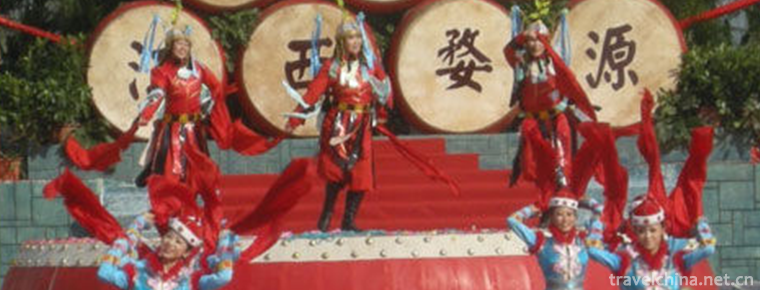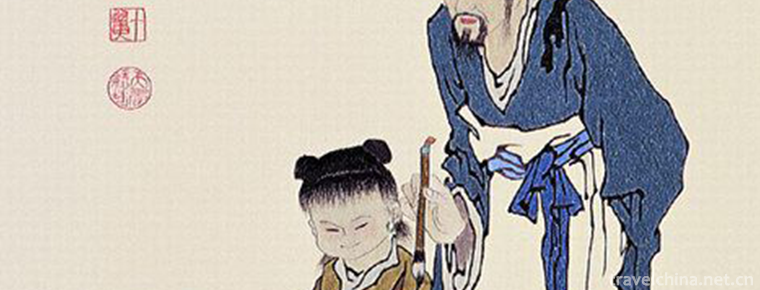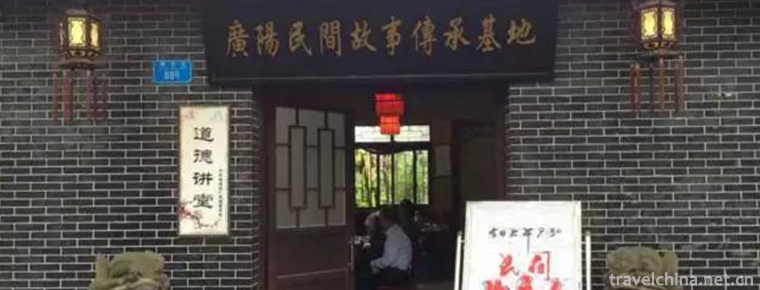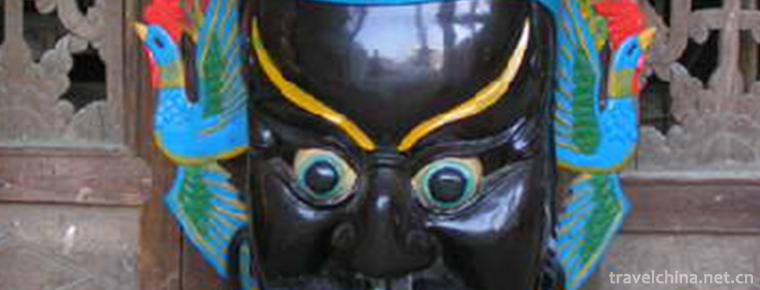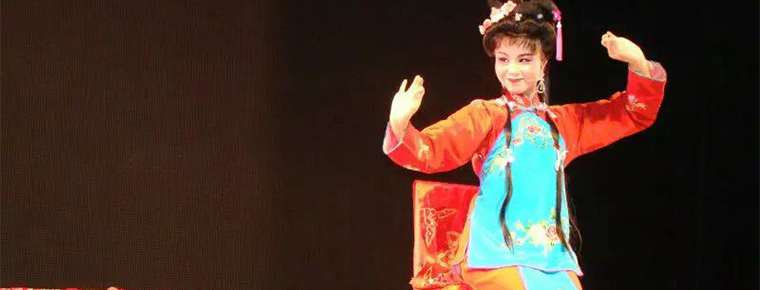Huangze Temple
Huangze Temple
Huangze temple is the only temple for Empress Wu Zetian in China. It is located on the Bank of Jialing River in Guangyuan City, Sichuan Province. In 1961, it was listed as one of the first batch of national key cultural relics protection units by the State Council; in 2006, it was rated as a national AAAA tourist attraction.
Huangze temple is not only the only Wu Zetian temple in China, but also contains 6 caves, 41 niches, 1203 cliff statues and inscriptions from the Northern Wei Dynasty to the Ming and Qing Dynasties. It is not only of high cultural relic value, but also of high ornamental and research value, and is praised as a treasure of traditional Chinese culture by experts.
geographical environment
Huangze temple is located on the West Bank of xijialing River and the east foot of Wulong mountain in Guangyuan City, Sichuan Province.
History and culture
Huangze temple was built in Kaiyuan period of Tang Dynasty. It was originally named "wunu Temple", and it is also called "Chuanzhu Temple". It is said that it is in memory of Li Bing and Erlang. In the Zhenguan period of Tang Dynasty, Empress Wu was born here when Wu Zetian's father, a warrior, was appointed governor of Lizhou. After the establishment of the Wuzhou regime, Empress Wu paid money to build a large-scale Chuanzhu temple at that time. Later, it was renamed "huangze Temple" with the meaning of "Emperor's magnanimity, spreading to his hometown". According to the "huangze Temple calligraphy stele" written by Chen Hongen in the Ming Dynasty, "huangze temple is said to be created by Wu Hou", and in the Qing Dynasty Zhang bangshen's "yunzhan Jicheng", it is also said that "the Empress Wu governs and the huangze temple is built here".
Some people also said that it was said that Empress Wu died as a God, so the people built a temple named "huangze" to pray for her "spirit in heaven" to be covered by her hometown. Therefore, her true image has been worshipped in the temple.
In 959, the local government rebuilt and expanded the temple to form the new temple of Empress Wu of empress Zetian of Tang Dynasty. At that time, the huangze temple was surrounded by "zetianmen", "tiantianlou", "lelou" (Theater), as well as "Maitreya Buddha Hall" and "Tieguanyin hall".
After that, many buildings were destroyed. Most of the existing buildings were in Qing Dynasty. Huangze temple, which has been in existence for more than 1300 years, has main buildings such as gate, er Sheng Temple, Zetian hall, big Buddha tower, Lvzu Pavilion, Wufo Pavilion, etc. the temple is surrounded by cliffs, overlooking the river, with carved beams and painted buildings. It is quite magnificent and magnificent with beautiful mountains and rivers.
Every year, on the 23rd of the lunar calendar, the Royal Ze temple will hold a grand temple fair. Guangyuan people will go to the Wulongtan area in front of the huangze temple to row boats and swim to the river bay to commemorate the birthday of Wu Hou.
Main attractions
Overview of scenic spots
Huangze temple now retains the gate, Zetian hall, er Sheng Temple, dafou tower, Xiaonanhai, luzu Pavilion, Wufo Pavilion, Wushi family temple, bell and Drum Tower and other buildings. There are newly built Queen's villa and relief wall of tomb chamber of Song Dynasty.
The second temple
Stepping into the gate of huangze temple, the first thing you can see is the second holy hall. In the center of the hall, there are two saints: Emperor Gaozong and Empress Wu.
In 649, Emperor Gaozong of Tang Dynasty ascended the throne. However, when Wu Zetian, the empress of the Tang Dynasty, was forced to stand up for the Empress Wu Zetian. Li Ji (Xu MaoGong) said, "why do you ask outsiders more about your Majesty's family affairs?" he finally made him abolish queen Wang in 655 and made Wu the queen. In the late years of Xianqing (656-661), Emperor Gaozong was suffering from wind and dizziness. She could not see clearly and was difficult to manage government affairs. Empress Wu Zetian gradually mastered the government affairs, and they were called "two saints" inside and outside the court. From then on, Wu Zetian became the ruler of real power, while Gaozong was in a position of power left aside. According to historical records, "after the first year of Linde (664), every time the emperor sat in the East and the back in the west, and no matter how big or small the government was, he heard it. The world had great power. He returned to the central palace, dethroned Zhizhi and killed life. It was up to the emperor to bow his hand, which was called" two saints "at home and abroad. This is a very rare phenomenon in Chinese history, which fully demonstrates Wu Zetian's outstanding political talent.
On the left and right sides of the hall, there are nine famous ministers in Gaozong and Wuzhou Dynasties: Li Ji, Li Yifu, Wei Yuanzhong, Li Zhaode, di Renjie, Lou Shide, Zhang cambi, Lai Junchen and Shangguan Waner.
Zetian Hall
Behind the two sacred halls is the Zetian hall. The hall was built in the Tang Dynasty, and was once called "Zhenrong Hall of Empress Wu" and "rear Hall of Zetian saint". Different from other "private" temples, there is no "grand hall" in huangze temple, a "government run" temple built by the Queen's Royal edict. Therefore, Zetian hall is the main hall of huangze temple. In the hall, there is a map of Wu's family. According to historical records, Wu Zetian's father, warrior Hu, was a native of Wenshui, Taiyuan. He was a timber merchant in Shanxi. In order to achieve his ideal, he went to join the army and met Li Yuan (Tang Gaozu). He was promoted to be the Minister of Sanpin industry (equivalent to the Minister of construction) in the third year of Wude (620). As one of the founding fathers of the Tang Dynasty, samurai Yu has always been trusted by Emperor Gaozu of Tang Dynasty and became an important official of the imperial court. After August of the eighth year of Wude (625 A.D.), samurai Yu took Shi Waifang, the governor of Yangzhou Dadu Prefecture, as an official. Originally, Emperor Gaozu of Tang Dynasty told him that he would only go abroad for half a year. But soon (the fourth day of June in the ninth year of Wude), Li Shimin launched Xuanwu Men soldiers, and Li Yuan abdicated. All the important officials in the Court changed into Li Shimin's cronies. Wu Shiyu was excluded and never returned to the court. In August of the ninth year of Wude (626), Li Shimin ascended the throne, that is, emperor, and changed his name to Zhenguan. The next year (627), samurai became governor of Lizhou.
There are three views on the date of Wu Zetian's birth. The first is in the seventh year of Wude (624); the second is in the eighth year of Wude (625); the third is in the second year of Zhenguan (628). According to the first two statements, Wu Zetian was born in Chang'an (now Xi'an, Shaanxi Province); if according to the third view, she was born in Guangyuan.
In any case, Wu Zetian spent her childhood and adolescence in Guangyuan. Her father died at the age of 12, and she and her mother were abused by their brothers. In 637, at the age of 14, Wu Zetian entered the palace and became a talented person of Emperor Taizong of Tang Dynasty. Emperor Taizong of Tang Dynasty doted on her very much at first and named her "Wu Meiniang", but soon ignored her. Wu Zetian has been a talented person for 12 years, but her status has not been promoted. During the period of serious illness of Emperor Taizong of Tang Dynasty, Wu Zetian and later Gaozong Lizhi, the son of Emperor Taizong of Tang Dynasty, established feelings. After Li Zhi succeeded to the throne, Wu Zetian changed from "talented person", "Zhaoyi" to "Queen". In 690 ad, Wu Zetian officially ascended the throne of "emperor" and became the only female emperor in Chinese history, changing her country name to Zhou. That year, Wu Zetian was 67 years old. In 705 ad, Zetian returned to the Zhou Dynasty in the Tang Dynasty, and Zhongzong succeeded him. On November 26 of that year, Empress Wu died, leaving an edict: "go to the emperor's name and call it the empress of Zetian."
In the middle of Zetian hall, there is the only stone statue of Empress Wu in China. According to the records of nine regions written in the Song Dynasty, when Wu Zetian became emperor, "she gave the temple its true appearance.". The stone statue, 1.8 meters high, is carved from the whole sandstone, more than 1300 years ago. The empress of the Tang Dynasty, with her broad forehead and wide neck, is serene and serene. She is wearing a Buddhist crown, a monk and nun robe, a plain silk shoulder, a collar around her neck, and her hands folded on her knees. It is said that this is the statue of Empress Wu in her later years. Although it looks like a Buddhist costume, it has the spirit of both human and God.
According to reports, this statue of Empress Wu's real face was robbed in 1949, when it was pushed down from the front of the incense case to separate its head and body. When it was restored in 1950, the neck of the statue was 1.5cm shorter than that of the original statue. In addition, the color and painting of clothes and ornaments are fading, which makes them more old. Fortunately, in 1993, Mr. Gou Shousheng, a Thai Chinese, donated 800 grams of gold foil to put on the gold clothes for this innocent statue.
There is a stone tablet of Empress Wu Zetian in the hall. On the stele, the empress is wearing a crown, wearing royal clothes, clouds and misty temples, and dancing with colorful clothes. It is engraved by the people of the Republic of China from the "Golden Wheel remains" in the "matchless biography" written by Chen Hongen of the Ming Dynasty. It is the expression of Empress Wu Zetian when she was "King". There is an ancient poem praising it: "the most beautiful woman, the most beautiful woman in the world, the most beautiful woman in the world, the most beautiful woman in the world, the most beautiful woman in the world. Liu Chi's orphan is a great disaster, and he looks up to his great achievements for thousands of years. The remnant mountains and rivers still leave a thin shadow, which still makes the City drunk with wild geese. "
On the fourth day of February in the second year of the reign of Emperor Wu Zhou (699), Wu Zetian went to Songshan for a Buddhist ceremony from Luoyang, and stayed at the prince's temple of Shengxian on Goushan mountain in Yanshi County on his return. He wrote the tablet and personally wrote it as a bibliotheca. On the surface, the inscription tells the story of Prince Ling's promotion to immortality, but in fact it praises the flourishing age of Wuzhou. The style of writing is graceful and fluent, and the mood is vertical and horizontal. The six characters on the inscription are "the stele of the prince ascending to immortality", which is written in "feibai style". The strokes are white. There are 33 lines of inscriptions, 66 characters in each line. Running script and cursive script are alternated, which is close to Zhangcao script style. The inscriptions on the inscriptions and the inscriptions on the inscriptions and the inscriptions on the inscriptions are written by Xue Ji and Zhong Shaojing, the famous calligraphers of the Tang Dynasty. Calligraphy lovers of all ages regard the tablet of Prince Shengxian as a treasure of calligraphy art.
In addition, there is also an inscription written by Song Qingling for huangze temple in 1963: "Wu Zetian is the only female emperor in Chinese history and an outstanding female politician in feudal times."
Wu family temple
On the north side of the gate of huangze temple, there are Fengge and bell tower. On the south side, there are holes written with "Heart Sutra", Wu family temple and Drum Tower. It is said that after the samurai came out as governor of Lizhou, "he recruited and collected the defectors, followed the old and the weak, was honest and upright, and had outstanding political achievements, which is quite popular among the people. Therefore, this temple is specially built to discipline it."
In the temple of Wu family, there are statues of Wu Zetian's family. In the middle are the warrior Yu and his stepwife Mrs. Yang. The original match of the warrior Yu is the Xiang Li family. He died in the sixth year of Wude. In April of the seventh year of Wude, Emperor Gaozu of Tang Dynasty personally acted as a matchmaker to marry his successor. Yang, the daughter of the Prime Minister of the Sui Dynasty, was later named the wife of Rongguo. After the marriage of Yang and samurai, she had three daughters. Wu Zetian was the second daughter of the Yang family. According to this, it is possible that Wu Zetian was born in 628. On the right are the two sons of samurai Yu and his original mate, Li Shi: Wu Yuanqing and Wu yuanshuang. On the left are the three daughters of samurai Yu and Mrs. Yang: the eldest daughter named Shun, whose name is Mingze. She married FA Cao Helan Yueshi of Yue palace. She was born with he lanminzhi and a daughter, but she was widowed. Later, she was granted a South Korean wife. She was lucky to be Gaozong, and after her death, she pursued the title of Madame Zheng. The second daughter's name is Yue, and the word is Mingkong, that is, Zhou (Zhao), that is, Wu Zetian. Ji Nu's name is not recorded in the history books. She married Guo Xiaoshen and died early.
Writing the hole of Heart Sutra
In the southeast of Wu's family temple is the drum tower, and in the northeast is the hole for writing the Heart Sutra. In the early years of the Tang Dynasty, Yan Zhenqing was the governor of Lizhou. He once wrote a volume of Xinjing, which was engraved here. Therefore, it is commonly known as writing the hole of Xinjing.
The main contents of the two statues, which were excavated in the middle of the sixth year of the reign of the Buddha, were found in the cave area of the sixth year of the sixth year of the reign of emperor Wudai, and the main contents of the sculptures are the statues of the Buddha in the sixth year (628), this time is consistent with the third statement of Wu Zetian's birth. Therefore, the two caves may have been opened for the blessing of Wu Zetian's birth. There are a group of Buddhist statues of Wu's wife and his wife in the caves, which are precious.
Buddha tower
The Grand Buddha tower is also called the Giant Buddha grottoes. Originally, there was no building. It was a cliff statue grotto beside Zetian hall. The building was first built in the reign of Daoguang in the Qing Dynasty, and then collapsed due to its disrepair. The building now seen is a new building funded by the State Administration of cultural relics in 1980. The famous calligrapher, Mr. Li Banli, inscribed a plaque with the words "Buddha tower" on the upper floor, so it is known as the "Giant Buddha tower".
The grottoes, 7 meters high, 6 meters wide and 3.6 meters deep, were excavated in the middle of the Tang Dynasty. Amitabha, the main Buddha, stands on the lotus platform, with his left hand curled up in front of his chest and his right hand with fearless seal. His posture is majestic and his expression is solemn and solemn. He sighed at the calamity of the cultural revolution. His fingers were clearly cut and replanted. I'm sorry.
The two disciples of Gaye and Anuo were supported by the master Buddha. GA Ye bares his right shoulder, holding the censer in his left hand and holding his fist in his right hand; Anuo twists beads in his left hand, raises his right hand up, and holds his thumb and middle fingers together. Guanyin on the outer side, and the two Bodhisattvas of the great momentum, are also carved with beautiful eyebrows and solemn and kind-hearted. The statues of Dharma protectors, vajras and warriors on the left and right sides are hard to distinguish, but they are still magnificent and extraordinary in shape.
This grotto is engraved with a statue of "benefactor", which can no longer be found in the "Buddhist world" of the whole country. He was dressed in an official uniform and a double winged hat made by the Tang Dynasty. He knelt down in front of the Buddha and prayed devoutly. Under the feet of the Buddha, he looked humble and insignificant. According to the textual research of Mr. Zhang Daqian, this "supporter" should be Li Xian, the emperor of Tang Dynasty who was abandoned. He prayed for his mother because he wanted to restore the emperor to please his mother. The other is that Prince Zhang Huai Li Xian. Li Xian once ordered Fan Ye to interpret the book of the latter Han Dynasty, which implied that the imperial power had been left behind and offended Empress Wu Zetian. Later, when Li Xian supervised the construction of the "huangze Temple", he asked the stone workers to carve their own statues at the foot of the Buddha to show their repentance.
Central pillar cave
The central pillar cave is located on the top of Zetian hall and on the left side of the Grand Buddha building (cave 45). It is the earliest statue of huangze temple and the only central pillar cave in Sichuan.
The central pillar grottoes, also known as Pagoda Temple grottoes and Zhiti grottoes, are 2.76 meters deep and 2.6 meters wide. The caves are about 13 cubic meters in length. The chambers are square and flat with a slight arc. The central column of the grottoes leads directly from the bottom to the top of the cave. One large niche and two small niches are opened on each of the three walls.
The central column is a complete stone column, and is also a Jingta with exquisite shape. It is composed of the base, body and top of the tower. On the first and second floors, there is a niche on each side, in which there are three statues of Buddha and Bodhisattva. The statues of these niches are carved in simple and simple way. The Buddha's robes are open from the front, and the lower edge is hung under the pedestal. The Bodhisattvas are standing on the left and right sides, and their long skirts are drawn to the ground. The broad sky clothes are V-shaped in front of the chest and cross the shoulders to form double angles like wings.
In the three niches on the three sides of the stone wall, there are two Bodhisattvas, one Buddha and two disciples. The Buddha statues are all long, while the Bodhisattvas are full of plump face, without any wreaths. The statues are firm and powerful and full of volume. The upper part of the three walls is decorated with Thousand Buddhas. The central pillar cave was first carved in, but the statues in the three niches were chiseled for later generations.
Collection of cultural relics
overview
Huangze temple is not only the only Wu Zetian temple in China, but also contains 6 caves, 41 niches, 1203 cliff statues and inscriptions from the Northern Wei Dynasty to the Ming and Qing Dynasties. It is not only of high cultural relic value, but also of high ornamental and research value, and is praised as a treasure of traditional Chinese culture by experts.
Relief stone carvings in Song tombs
Among the cultural relics in huangze temple, a group of relief stone carvings from Song tombs are undoubtedly the treasures of stone carving art in Song Dynasty. These 24 relief stone carvings were unearthed from Bazi song tombs around Guangyuan City from 1974 to 1980. Each piece is 2 meters long and 0 wide. 8 meters, all of which are carved by local yellow sand rock. According to the records of the land purchase volume cleared out of the tomb, the production date should be the Southern Song Dynasty, and the latest song tomb has been more than 780 years ago.
After careful repair by cultural relic workers, it is inlaid with a total length of 28 meters, a height of 4 meters and a thickness of 0. 8 meters on the screen wall. It can be divided into seven categories, such as the painting of four immortals and beasts, drama performance, grand ceremony performance, men and women warriors, filial piety story, tomb master's life and flowers. For visitors to watch.
In the painting of four immortals, there are four beasts: Qinglong (East), white tiger (West), Zhuque (South) and Xuanwu (North). It is said to be the holy beast of Weizhen and Fangfang to avoid evil and prosperity.
There are seven pictures of drama performance and Daqu performance. In the pictures, the male performers are wearing long T-shirt with round neck, belt and soft hat or hard wing crown. The performance of the forehand dance and foot dance is performed; the female dancer or wears a bun or braid, or wears a long or short shirt, holds a good board in her hand, and plays the horizontal flute, vertical flute, Lusheng, suona, Sanxian, handdrum, waist drum, flat drum, toilet, barrel drum, etc. Each shape is different, vivid and interesting. In the picture of samurai and samurai, the figure is about 1 high. 45—1。 51 meters, male warrior wearing helmet, wearing tiger head armor, holding a long axe, thick eyebrows and bright eyes, powerful and angry. The female warrior wears a female crown, a soft armor robe and a long axe in hand. Her eyebrows are vivid and solemn. It is the only one found in the tombs of Song Dynasty in China.
There are five filial piety stories in the picture, all of which are based on the filial piety stories of "Wang Xiang lying on ice", "Meng Zhong crying bamboo shoots", "Qiao Zhuang collecting firewood", "Dong Yong farewell to his wife" and "strangling the tiger to save the father", which are all based on the filial piety stories of the 24 filial piety schools.
In the painting of the tomb owner's life, there are the pictures of raising a sedan chair, a chair, a horse, a kitchen, a night dream, a recitation of Buddha, and incense burning. Among them, two of them are the painting of cooking. In one picture, there are two maids, one carrying water and the other sitting in front of the stove, blowing fire with bamboo tube, firewood beside the stove, and six steamers on the pot, which vividly evokes the spirit; especially, the painting of "flying pot drinking wine and serving banquet" is vividly vivid. On a table surrounded by a table, there are pots, melons, fruit boxes, etc., but there are no waiters. The wine pot is hanging in the air, as if there are "invisible people" drinking wine in the cup. The idea is ingenious, and it can arouse people's thinking.
In addition, in the painting of flowers, there are stone carved peonies, peonies and lotus flowers, showing the elegance and wealth of the tomb owner, which is of great symbolic significance.
In a word, these stone carvings of song tombs are not only of high ornamental value, but also the most valuable material materials for modern people to study social customs, culture and art, religious tradition and moral concepts of Song Dynasty.
Tablet of Guangyuan Mansion
The other one is "Guangyuan mansion memorial tablet". The monument is 2 high. It is 6 meters wide and 1. 38 meters, 0. 24 meters. The original stele was preserved in the original site of the old county government office and moved to huangze temple in October 1974.
According to the records of Guangyuan County during the reign of Qianlong, "from the 18th year of emperor Longfei to Ding Chou of Yuan Dynasty (AD 1286), Professor Zhang Kai of Guangyuan Lu congxue wrote an article, Wang Shiming, magistrate of Guangyuan Road administrator's office, established a stone.". There are "... In the inscription It is the throat of Shu, an important place in ancient and modern times, with beautiful mountains and rivers, and the construction and official system of all dynasties are under control. In the spring and Autumn period, it was called "Yuan" in the spring and Autumn period. Today, the word "Guangyuan" is also called "Guangyuan". Is there any reason why the word "Guangyuan" can be heard first In June of the 26th year of Zhiyuan. From the inscriptions, we can understand the origin of the name "Guangyuan".
This "Guangzheng stele" has been more than 700 years ago. There are 923 inscriptions on the stele. Today, it is impossible to identify the inscriptions. Fortunately, it was recorded in the annals of Guangyuan County in the 22nd year of Qianlong reign (AD 1757), which left a valuable historical material for later generations to understand the history of Guangyuan.
Today, when people walk into Guangyuan huangze temple, it seems that they have entered a labyrinth of history and the palace of art
Stele of twelve stories of sericulture
In the Qing Dynasty, there was a name of Guangfeng County in the Qing Dynasty. This man was born in hubeishan. He was born in 1812, the 17th year of Jiaqing in Qing Dynasty. He was awarded the magistrate of Zhaohua County by military service. After taking office, he went deep into the folk to explore the way to enrich the people, and called on the county people to plant mulberry and raise silkworms. Gradually came to the theory of planting mulberry and raising silkworm to get rich. Four years later, the county magistrate was transferred to Guangyuan. As in the past, he advocated planting mulberry and raising silkworms, and registered all the mulberry trees in the county. Under his painstaking management, all roads in Guangyuan County are lined with mulberry trees and green roads. In 1827, Zeng Fengji was promoted to be the magistrate of Songpan. Before he left, he drew this set of stone inscription "Twelve pictures of sericulture" which was very similar to a comic book. He warned the local people and the succeeding county magistrate not to neglect the cause of mulberry planting and sericulture for the benefit of the people.
The stele of "twelve stories of sericulture" is 1. It is 3 meters in length and 5.8 meters in length. The first picture shows a picture of Leizu resting on a mulberry branch and a silkworm falling on top of Leizu's head. This picture is based on the legend of Leizu and Baima. It is said that in ancient times, Leizu's father was a tribal chief. Unfortunately, he fought with foreign enemies in a hunting trip, and the chief was defeated and captured. After learning the news, Leizu was very anxious, so he called on all the tribal people to work out a plan to save his father, and made a promise in public that whoever rescued Leifu would marry him as his wife. All the members of the army were not good at planning. However, when the chief's big white horse heard the words, he roared and ran away. In the evening, he took Leifu back. But in the next few days, white horse does not eat or drink, Lei father is very strange. Asked the public, Leizu then talked about the promise to save his father's marriage. Lei's father was furious and said, "how can human beings and animals get married?" So he killed the white horse and skinned it in the hot sun. But just after the horse skin was exposed to the sun, a strong wind suddenly rose. The horse skin and Leizu were rolled up into the sky together. After a thunder, Leizu turned into a silkworm worm and hung down from the sky leisurely. The white horse bone buried in the soil gradually grew a big tree. The silkworm hung on the tree, fed on leaves and spun silk to cocoon. Later generations of this tree called it sad tree or mulberry tree, implying the sad past of Leizu.
The four pictures of mulberry selection, mulberry planting, mulberry tree planting and mulberry tree planting in the twelve events of sericulture stele show the scene of mulberry cultivation in Qing Dynasty. These methods are still used in today's mulberry planting activities. In addition, the eight pictures of "Wozhong", "breeding silkworm", "feeding silkworm", "sleeping", "shangqun", "cocoon separation", "pickled silkworm" and "silk reeling" show the whole process of silkworm rearing, silk reeling and weaving in Qing Dynasty. The rubbings of this group of stone inscriptions were collected by the former state textile Ministry and the Shanghai Silk Museum, and become precious historical materials and ancient popular science creation art treasures in China.
Guangzheng tablet
In huangze temple, there are two common but rare steles. These are Guangzheng stele, which was engraved in 959 a.d. by Meng Zhixiang (Meng Chang), the king of the late Shu Dynasty, and the Guangyuan mansion tablet written by Wang Shiming, the general affairs officer of Guangyuan Road in Qianlong of Qing Dynasty (1286 A.D.).
The former Guangyuan huangze temple has a large scale. When Baocheng railway was built in 1954, the subgrade passed through the center of huangze temple building group, and many ancient temple buildings were demolished. When the roadbed was excavated, Guangzheng stele was found and unearthed from the ruins. The inscription is "the new temple of Empress Wu of empress Zetian of Tang Dynasty in huangze temple, governor's office of Lizhou". This inscription was not published in the old and new Guangyuan county annals. There are 29 lines of inscriptions, 26 to 27 characters in each line. Unfortunately, the lower section is incomplete, about a cross. In the text, when the word "Queen of heaven" or "after" is found, it must be raised to the top of the grid, and when encountering honorifics, there are three empty spaces, which are highly respected for the military reserve. The reconstruction of the new temple was only 254 years after Wu Hou's death. This stele and the poem written by Li Shangyin in Tang Dynasty are the important historical materials for Guo Moruo to prove that Wu Zetian was born in Guangyuan. It can be seen that this monument is of extraordinary value.
Practical information
Ticket information
Ticket price: 50 yuan
Children less than 1.1 meters in height are free of charge; elderly people over 70 years old with old age card or ID card, active servicemen with officer's certificate and disabled person with disability certificate are free of charge
Opening Hours
9:00-17:30
Traffic information
Guangyuan bus passes (stops) huangze temple bus routes: No.1, No.15, sightseeing bus.
Related reports
”On the afternoon of March 20, after visiting huangze temple, members of the national network media gathering group of "beautiful Sichuan, Sichuan Road and flower fragrance" sincerely sighed. Huangze temple is the only temple for Empress Wu Zetian in China. It was built in the late Northern Wei Dynasty. After the continuous development of the Northern Zhou, Sui and early Tang Dynasties, it gradually became a large-scale temple and reached its peak in the prosperous Tang Dynasty.

-
Changli folk songs
Changli folk song is a kind of local folk ditty inherited from generation to generation by Changli people. The content of singing can be divided into four categories: labor chant, story and legend, lo.
Views: 184 Time 2019-04-15 -
Drum Dance
Dance and drum dance is a kind of folk dance of Miao nationality in China. Miao people's "encouragement" has a long history. The written records of Miao people's drumming.
Views: 130 Time 2019-05-01 -
Gu embroidery
Gu embroidery, a traditional folk art in Shanghai, is one of the national intangible cultural heritages..
Views: 139 Time 2019-05-01 -
Folk Stories in Guangyang Town
"Guangyang Folk Stories" is the general name of folklores and stories widely spread in Guangyang Town. Guangyang folk tales are popular in the local area..
Views: 188 Time 2019-05-01 -
Construction Techniques of Traditional Residential Buildings in Southern Fujian
South Fujian residential building technology is a unique traditional architectural technology originating in Quanzhou, which began in Tang and Five Dynasties, is the mainstream of ancient architectura.
Views: 154 Time 2019-06-05 -
Pingxiang Xiangdong Nuo Mask
Nuo mask is an important part of Nuo culture. It is used in Nuo etiquette, Nuo dance and Nuo opera. Nuo mask in eastern Hunan is an excellent traditional Chinese sculpture with a long history. Eastern.
Views: 167 Time 2019-06-09 -
Sizhou opera
Sizhou Opera is one of the four major operas in Anhui Province. Its original name is Lahun Opera. It has a history of more than 200 years. Many people think that it originated in Haizhou, northern Jia.
Views: 120 Time 2019-06-16 -
Chengdu Jinsha Site Museum
Chengdu Jinsha Site Museum, a national AAAA tourist attraction, is located at No.2 Jinsha Ruins Road, Qingyang District, Chengdu City, Sichuan Province. It covers an area of 456 Mu and a building area of 38000 square meters..
Views: 211 Time 2020-11-06 -
Jiang Weicheng
Jiangweicheng site is a representative and important site in the upper reaches of Minjiang River. It is located in the mountain behind the Weishi school in Weizhou Town, Wenchuan County..
Views: 194 Time 2020-11-06 -
Overview of Guangyuan
In 2019, the GDP of Guangyuan will reach 94.185 billion yuan, an increase of 7.5% over the previous year, which is the same as that of the whole province. Among them, the added value of the primary industry was 15.301 billion yuan, an increase.
Views: 350 Time 2020-12-15 -
Nanchong science and technology
In 2019, Nanchong implemented 97 key science and technology plan projects, an increase of 7.8% over that in 2018, including 83 national and provincial science and technology plan projects. It won 11 provincial science and technology progress awards. In the whole year.
Views: 144 Time 2020-12-17


